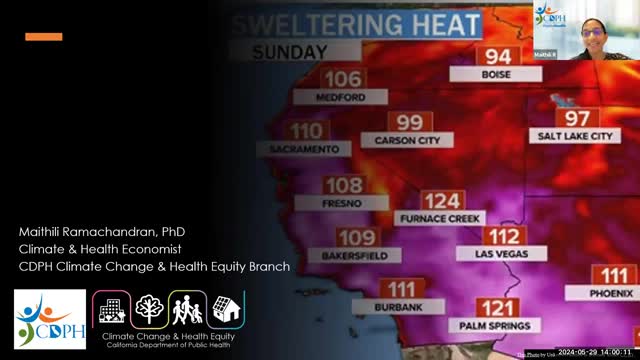California tackles health risks from climate change heat waves
June 07, 2024 | California Department of Public Health, Agencies under Office of the Governor, Executive, California

This article was created by AI summarizing key points discussed. AI makes mistakes, so for full details and context, please refer to the video of the full meeting. Please report any errors so we can fix them. Report an error »

In a recent government meeting, experts discussed the urgent need to quantify health damages from climate change in California, focusing particularly on the impact of heat waves. The presentation outlined a three-part framework: identifying which health damages to quantify, understanding how these damages affect vulnerable populations, and formulating effective policy responses.
The speaker emphasized the significance of heat waves as a primary climate-related health risk, linking them to excess mortality. A report from the California Department of Public Health (CDPH) indicated that a heat wave in September 2022 resulted in approximately 395 deaths. Using the value of a statistical life (VSL), estimated at around $11 million, the potential economic cost of preventing such deaths could reach $4 billion.
Looking ahead, projections indicate that by the end of the century, California could face mortality costs from extreme temperature events amounting to 4% of national income under high emission scenarios. The discussion highlighted the importance of utilizing climate models to forecast future heat waves and their associated mortality, translating these projections into economic terms to support climate action.
The meeting concluded with a call for economics to play a pivotal role in evaluating trade-offs and impacts of climate policies, particularly in promoting health equity. The team leading these efforts includes Dan Wu, who oversees cross-sector collaborations, and Elizabeth Rhodes, who manages local assistance related to climate and health equity initiatives. The discussions underscored the critical intersection of climate change, public health, and economic policy in shaping California's future resilience strategies.
The speaker emphasized the significance of heat waves as a primary climate-related health risk, linking them to excess mortality. A report from the California Department of Public Health (CDPH) indicated that a heat wave in September 2022 resulted in approximately 395 deaths. Using the value of a statistical life (VSL), estimated at around $11 million, the potential economic cost of preventing such deaths could reach $4 billion.
Looking ahead, projections indicate that by the end of the century, California could face mortality costs from extreme temperature events amounting to 4% of national income under high emission scenarios. The discussion highlighted the importance of utilizing climate models to forecast future heat waves and their associated mortality, translating these projections into economic terms to support climate action.
The meeting concluded with a call for economics to play a pivotal role in evaluating trade-offs and impacts of climate policies, particularly in promoting health equity. The team leading these efforts includes Dan Wu, who oversees cross-sector collaborations, and Elizabeth Rhodes, who manages local assistance related to climate and health equity initiatives. The discussions underscored the critical intersection of climate change, public health, and economic policy in shaping California's future resilience strategies.
View full meeting
This article is based on a recent meeting—watch the full video and explore the complete transcript for deeper insights into the discussion.
View full meeting
